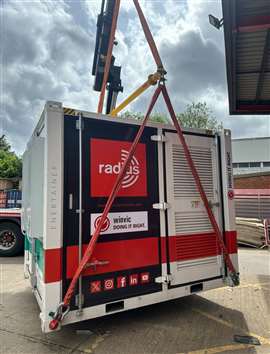BESS assists decarbonization of tower cranes, job sites
12 September 2024
The historic city centre of Birmingham, England was once known as the Gun Quarter due to the fact it had been a hub of gun manufacturing. In recent years, however, it has become the focus of a building boom centred around student accommodation blocks for Birmingham’s four universities. That means tower cranes are a common sight.
Crown Place is a 33-storey tower that has nine- and twelve-storey ‘shoulder blocks’ on the sides. Located on Birmingham’s busy Lancaster Street, contractor Winvic Construction of Northampton, England, is building the tower with the help of a Potain MR 225A luffing jib tower crane. The crane is unique among its many counterparts dotting the Birmingham skyline, as it is powered by a rechargeable battery energy storage system (BESS) that supplements grid power. The BESS also powers the Lancaster Street site.
 The Potain MR225A luffer, powered by the Enertainer unit, at work on the Lancaster Street site. (Photo: Radius Group)
The Potain MR225A luffer, powered by the Enertainer unit, at work on the Lancaster Street site. (Photo: Radius Group)
Known as the Enertainer — a combination of “energy” and “container” — the BESS is a 2.6 square metre (28 sq. ft.), 7.3 tonne box holding 30,000 lithium-ion battery cells. Together, they store enough power to address the energy peaks needed by up to three tower cranes.
While electric tower cranes are nothing new — they have been built to run on electricity since the 1970s — their high power demands often make it a challenge to connect them directly to the grid, if there is even a connection available. Hong Kong-based Ampd Energy, the makers of the Enertainer unit, say the BESS addresses that by providing the short bursts of high electric power necessary for lifting loads.
Supplied to Winvic by Radius Group, also of Northampton, the crane is Radius’ first investment in energy storage systems for crane power. Rachel Swanston, marketing manager at Radius, said it was seeing growing demand for alternative power solutions for tower cranes.
“This is driven by the construction industry’s focus on sustainability and efficiency,” she said.
Growing BESS Demand
Ampd Energy, founded in 2014, said it has also seen a massive surge in business since it started marketing its products to the construction industry five years ago.
“Our battery system was born out of specific demand from the construction industry for a unit that can handle the very niche requirements of power as well as handle the tough environments on a construction site,” said Hayley Arckless, UK country manager for Ampd Energy. She added that before the advent of BESS, the only other option was diesel generators, which she said are not only heavy polluters but are inefficient and have a high total cost of ownership (TCO).
 The Enertainer unit being delivered to the Lancaster Street site. (Photo: Radius Group)
The Enertainer unit being delivered to the Lancaster Street site. (Photo: Radius Group)
“An Enertainer helps contractors use less power, more efficiently,” Arckless said. “It saves costs by taking a small trickle charge from a small power source (usually grid) which negates the need to wait for costly grid upgrades, renting generators, bowsers and other technologies, not to mention that it can eliminate the huge diesel or biofuel bill altogether.”
The Enertainer charges at a rate of between 10 and 80 Amps from a 320 - 440 V AC mains supply.
According to Ampd, every switch from a diesel generator to one of its units saves 130 tonnes of carbon dioxide (CO2) per year. The Enertainer also adds an extra level of power security to a site.
“Storing energy in an Enertainer to use efficiently means if there is an outage in the original power source, sites can keep working to ramp down safely,” Arckless said.
Arckless admits that the Enertainer is only as sustainable as the electricity it stores, which can vary significantly depending on how much electricity is produced from renewable sources, such as wind and solar.
BESS Alternatives
Contractors looking to reduce the carbon footprint of tower cranes do have other options. These include flywheels, which store sudden spikes in electricity as kinetic energy and flatten out electricity demand on generators. Lead-acid batteries are also being used in some cases. However, Ampd doesn’t see itself as competing with such technologies, as it’s solutions can solve several problems and power an entire job site.
“A flywheel for example, is a great technology for peak shaving and reducing a fuel bill on one piece of equipment,” Arckless said. “A lead acid battery might be good for small levels of stable load requirements like overnight lighting or cabin welfare, but the lifespan is much shorter, and it needs to be paired with an equivalent sized generator to power high loads like a tower crane, so saving opportunities are limited.”
According to Arckless, Enertainer units could further assist decarbonization efforts by working alongside hydrogen generators or fuel cells.
“Hydrogen is a very interesting technology, but unfortunately it is quite cost-prohibitive at scale,” she said. “However, we think we can solve this barrier to entry by working together. Pairing a battery with a hydrogen generator as a power source enables the user to significantly downscale the generator size to as low as 75 kVA, creating a fully zero-emission and low-carbon power solution for construction.”
CONECTAR-SE COM A EQUIPE







